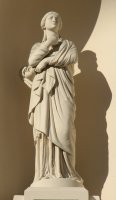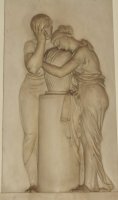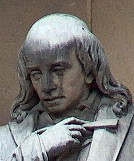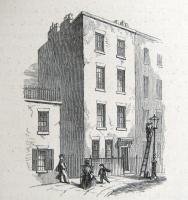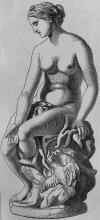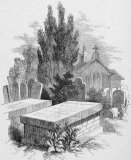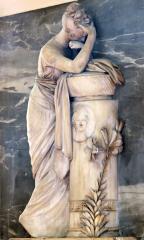John Flaxman (1755-1826)
The sculptor John Flaxman is one of the best-known British sculptors, better known today for his designs for Wedgwood porcelain than his larger sculptural works, and perhaps best known of all from his line drawings. He is the epitome of the Classical designer, favouring harmonious and ideally perfect Classical Greek figures, gracefully arranged: the word that most readily comes to mind when seeing his work is 'pure'.
John Flaxman.
Flaxman was a native of York, the son of a maker of plaster casts, studied at the Royal Academy Schools from 1769, and in 1775 took up his post as a designer for Wedgwood. From 1887-94 he directed Wedgwood's studio in Rome,and while in that city, made several large sculptural groups. He also started designing for book illustrations - his first attempts at art had been drawing - including for the Iliad, the Odyssey and Dante's Divine Comedy. In 1794, Flaxman returned to England, settling in London where he lived just south of Great Portland Street station, close to Fitzroy Square, home of many artists. The road where he lived is now called Greenwell Street, and the picture below shows the rather plain house which he lived in. It is gone now, but similar London brick houses survive round the corner in Cleveland Street, including one lived in rather later by the American artist Samuel Morse, who also invented the Morse Code.
Flaxman's house, 7 Buckingham Street, now Greenwell Street, London.
Flaxman was elected to Associate of the Royal Academy in 1897, and became a full Royal Academician in 1800. He became the Royal Academy's first Professor of Sculpture in 1810, and held that position until the year of his death 1826. His lectures, widely printed and quoted, increased his influence beyond the large number of young sculptors he taught directly.
Flaxman statue of Venus for Wedgwood.
Sculpture by Flaxman mostly consists of church monuments. It can be seen in Westminster Abbey (Burns, Kemble, Mansfield) and St. Paul's Cathedral (Nelson), and many large churches and cathedrals have one or two pieces by him - no less than six are in Chichester Cathedral. He has a large number of mostly smaller monuments in churches across the country, often with a single figure or a pair, most typically a mourning girl leaning on a funereal urn. Various pieces by him are scattered across this website on the church pages, and for example two rather nice, typical small monuments by Flaxman in Leyton Church are shown on this page; two more, in Epsom Church, are shown on this page. A few more pictures at the top of this page - hover for caption or click any picture to enlarge. He was buried in the churchyard of St Giles in the Fields, where there is a sculptured plaque in his memory based on one of his works - see the top and bottom of this page.
Many of Flaxman's carved figures have a sense of quietude, even when in apparent action, in the typical ancient Greek style, and this was most suitable for his many memorial works. His female figures, human and angelic, are also Greek in costume, with heavy, enveloping long dresses, hoods, and sleeves, or lighter materials that accentuate rather than conceal the body; a typical one below is in Richmond Church. Their figures are perhaps a little more fleshy than in later, Victorian times, with a a breadth of hip and soft roundedness to the shoulders and arms, as suggested by the engraving above. His males come in two forms - a solid, muscular type, and more frequently, a youthful, slender type which seems a little over-soft to later times. Flaxman's drapes can be very simple, falling in straight lines, or subtle studies in complexity worthy of the best Hellenic naiads - but in repose rather than motion. While Flaxman made the designs, and figures in plaster, small or full-sized depending on the complexity of the subject, they were generally carved by his studio assistants. Regardless, it is always a pleasure to come across one of his pieces in a quiet church.
Typical female figure by Flaxman, Lowther monument, Richmond Church.



